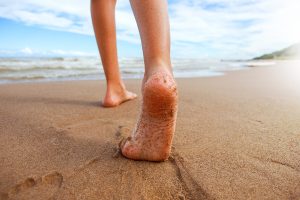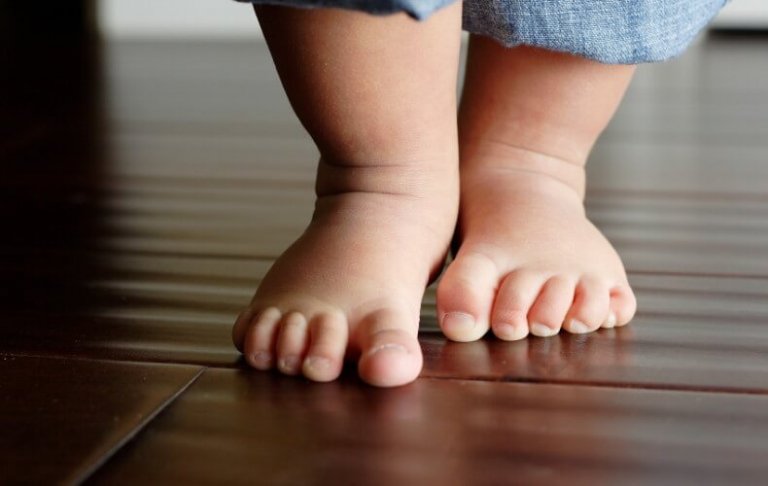How to Correct Bow Legs in Children

As little ones start to take their first steps, they may develop certain orthopedic disorders such as bow legs. This shouldn’t be a major concern for parents, since most of these disorders can be corrected naturally.
Bow legs or Genus Varus is a pathology that is characterized by a slight tilt outwards of the tibia. This generates a separation of the knees which creates the appearance of a bow.
Is it possible to correct this disorder?
This disorder can be noticed when children who are learning to walk separate their knees and project them outwards. The good news is that it can be corrected.
It’s a physiological anomaly which is paired with the elasticity of the child’s muscular system. In most cases, the issue evolves in a positive way as the child gains body mass and solidifies their bones.
What should you do if your child has bow legs?
The first step is to wait and observe the child’s evolution. In most cases, the bow corrects itself.
The child’s growth should be recorded frequently and you should be attentive to their body’s development. This way you’ll be able to detect if the bow decreases.
If the child starts walking and the bow persists, it’s best to seek the help of an orthopedic specialist. If you take your child to the specialist periodically they will be able to indicate the most appropriate treatment regime.
It’s also important to evaluate their ingestion of vitamin D. If the concentration of vitamin D in their system is low, it could cause rickets.
Rickets is one of the causes of bow legs in children; increasing the consumption of vitamin D can effectively prevent it.
Treatment for bow legs
A common medical treatment to consider is the use of orthopedic knee braces.
These braces are indicated in children who have bow legs for a prolonged period of time. The treatment with knee braces consists of using them until the child’s bones solidify.
Orthopedic shoes are another option if the child continues to have bow legs after reaching the age of 4. Orthopedic shoes should be used under the strict supervision of your doctor.
Keep in mind that these sorts of treatment are only used if the problem is very serious or if the child presents another associated disease.

Can bow legs be prevented?
There is no precise formula to prevent this anomaly, beyond preventing rickets. However, practicing good habits can be useful when it comes to preventing bow legs.
Here are some examples of good habits:
- Expose your baby to sunlight early in the morning in order to provide them with vitamin D.
- Prevent childhood obesity.
- Promote short walks. Walking can develop thigh muscles which prevent the knees from coming together.
“This disorder can be noticed when children who are learning to walk separate their knees and project them outwards.”
How to correct bow legs?
Here are some aspects that can be applied daily in order to improve this condition:
-
Posture while walking
The first thing parents should do is help the child walk correctly. Make sure the child keeps their back straight while walking, sitting and even while sleeping.
When it comes to babies, when they fall asleep, a thin pillow can be placed under their neck and their knees in order to stretch and rest their spine.
-
Exercise
There are some exercises that are beneficial for correcting bow legs in children. One of them, for example, is to place them face up and bend their knees in order to make them touch their stomach. This should be done patiently and delicately.
You can also cross their legs, put one arm behind their neck and hold it with the other hand. This will help strengthen the child’s back and align their posture while sitting and walking.
You can sing to them or tell them a story while performing these exercises in order to prevent them from getting bored.
Practicing Pilates is another great option. Pilates helps improve posture and strengthen the knees and thighs.
Yoga can also be a great technique to improve the alignment and flexibility of your child’s extremities. Yoga may be difficult for them to adapt to at first, but they’ll improve with time.

-
Good nutrition
Their diet should be balanced and natural. Make sure their diet includes minerals and vitamins such as calcium and vitamin C and D.
-
Massages
Massages can also help correct bow legs. In addition, they can be relaxing for the little one. Massages can help reinforce their back and their legs.
In conclusion, parents can help correct their children’s bow legs. In order to do this however, parents must be patient and perseverant.
Anxiety to achieve results in a short period of time will do nothing but sabotage their improvement.
As little ones start to take their first steps, they may develop certain orthopedic disorders such as bow legs. This shouldn’t be a major concern for parents, since most of these disorders can be corrected naturally.
Bow legs or Genus Varus is a pathology that is characterized by a slight tilt outwards of the tibia. This generates a separation of the knees which creates the appearance of a bow.
Is it possible to correct this disorder?
This disorder can be noticed when children who are learning to walk separate their knees and project them outwards. The good news is that it can be corrected.
It’s a physiological anomaly which is paired with the elasticity of the child’s muscular system. In most cases, the issue evolves in a positive way as the child gains body mass and solidifies their bones.
What should you do if your child has bow legs?
The first step is to wait and observe the child’s evolution. In most cases, the bow corrects itself.
The child’s growth should be recorded frequently and you should be attentive to their body’s development. This way you’ll be able to detect if the bow decreases.
If the child starts walking and the bow persists, it’s best to seek the help of an orthopedic specialist. If you take your child to the specialist periodically they will be able to indicate the most appropriate treatment regime.
It’s also important to evaluate their ingestion of vitamin D. If the concentration of vitamin D in their system is low, it could cause rickets.
Rickets is one of the causes of bow legs in children; increasing the consumption of vitamin D can effectively prevent it.
Treatment for bow legs
A common medical treatment to consider is the use of orthopedic knee braces.
These braces are indicated in children who have bow legs for a prolonged period of time. The treatment with knee braces consists of using them until the child’s bones solidify.
Orthopedic shoes are another option if the child continues to have bow legs after reaching the age of 4. Orthopedic shoes should be used under the strict supervision of your doctor.
Keep in mind that these sorts of treatment are only used if the problem is very serious or if the child presents another associated disease.

Can bow legs be prevented?
There is no precise formula to prevent this anomaly, beyond preventing rickets. However, practicing good habits can be useful when it comes to preventing bow legs.
Here are some examples of good habits:
- Expose your baby to sunlight early in the morning in order to provide them with vitamin D.
- Prevent childhood obesity.
- Promote short walks. Walking can develop thigh muscles which prevent the knees from coming together.
“This disorder can be noticed when children who are learning to walk separate their knees and project them outwards.”
How to correct bow legs?
Here are some aspects that can be applied daily in order to improve this condition:
-
Posture while walking
The first thing parents should do is help the child walk correctly. Make sure the child keeps their back straight while walking, sitting and even while sleeping.
When it comes to babies, when they fall asleep, a thin pillow can be placed under their neck and their knees in order to stretch and rest their spine.
-
Exercise
There are some exercises that are beneficial for correcting bow legs in children. One of them, for example, is to place them face up and bend their knees in order to make them touch their stomach. This should be done patiently and delicately.
You can also cross their legs, put one arm behind their neck and hold it with the other hand. This will help strengthen the child’s back and align their posture while sitting and walking.
You can sing to them or tell them a story while performing these exercises in order to prevent them from getting bored.
Practicing Pilates is another great option. Pilates helps improve posture and strengthen the knees and thighs.
Yoga can also be a great technique to improve the alignment and flexibility of your child’s extremities. Yoga may be difficult for them to adapt to at first, but they’ll improve with time.

-
Good nutrition
Their diet should be balanced and natural. Make sure their diet includes minerals and vitamins such as calcium and vitamin C and D.
-
Massages
Massages can also help correct bow legs. In addition, they can be relaxing for the little one. Massages can help reinforce their back and their legs.
In conclusion, parents can help correct their children’s bow legs. In order to do this however, parents must be patient and perseverant.
Anxiety to achieve results in a short period of time will do nothing but sabotage their improvement.
This text is provided for informational purposes only and does not replace consultation with a professional. If in doubt, consult your specialist.








